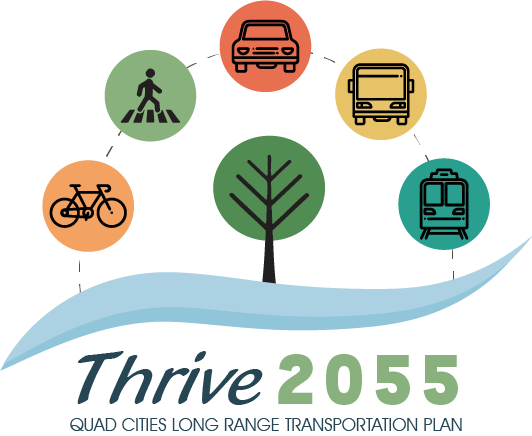December 19, 2018 – Sam Shea, District 6 planner for the Iowa Department of Transportation (DOT), reported on the status of planning for improvements to the Interstate 80 corridor and bridge over the Mississippi River. Both the Iowa and Illinois DOTs are now preparing to conduct a Planning and Environmental Linkages Study for the I-80 Bridge. Planning and Environment Linkages (PEL) represents a collaborative and integrated approach to transportation decision-making. The PEL process considers environmental, community, and economic goals early in the transportation planning process and uses the information and analysis developed during planning to inform the environmental review process. The common benefits of PEL are to:
- Reduce duplication
- Assist the environmental review process
- Develop documentation
- Save costs and time
- Provide a holistic and flexible approach
- Enhance community involvement
- Improve relationships and coordination
The I-80 Bridge was originally constructed in 1966 and included 28 spans using wide-flange beams/ welded plate girders on reinforced concrete piers. The deck was widened in 1990 and 1995. This type of construction leads to recurring issues including potential fracturing and being prone to vibration. Emergency repairs were performed in 2010 requiring closure of eastbound lanes during the summer. Also, vibration due to cantilevered exterior lanes necessitated replacement of lights. Widening of the existing structure is infeasible, and the existing waterway navigational channel configuration is not optimal for river traffic.
The Iowa Department of Transportation conducted an Interstate 80 System Study. The study included an analysis of geometry, physical condition, traffic operation, and safety from Interstate 280 to the Mississippi River. The traffic on Interstate 80 in the Quad Cities is higher than many areas in the state.
The interchange at I-80 and I-280 has over 58,000 entering vehicles with 70% growth in future traffic expected. The north and westbound bridges at this interchange are rated poor for width. Reconstruction of the interchange would potentially eliminate left hand exits that don’t meet current interstate design standards. In 2008, the City of Davenport worked with Iowa DOT on an analysis of the alignment of the Kimberly Road at I-280 interchange. The interchange is less than a half mile from the I-280 at I-80 interchange. Current safety standards require at least a one-mile separation between interchanges.
The I-80 and Northwest Boulevard interchange in Davenport has over 51,000 entering vehicles per day with 23% future growth in traffic expected. Even though the interchange was recently improved, three of four ramps at this interchange are rated poor for geometry due to higher than anticipated truck volumes. The I-80 Study recommended reconfiguration of this interchange to a converging diamond.
The I-80 and U.S. 61 interchange in Davenport is very congested. There are over 78,000 entering vehicles per day with 28% growth in traffic expected. The merging lanes onto I-80 are inadequate, contributing to 232 average crashes. All of the ramps at this interchange are rated poor for geometry and improvements will require increasing the length of ramps and weaving areas.
Iowa DOT staff and Federal Highway Administration worked with City of Bettendorf staff to complete the Middle Road Interchange Justification Report (IJR). An IJR or an Interchange Operations Report (IOR) is required for major improvement projects on interstate interchanges, and only I-80 at Middle Road has a completed report. The interchange in 2015 had nearly 36,000 entering vehicles, and with recent development, these numbers are even higher today. Plus, 67% growth of traffic is expected in the future. The interchange has not been updated since its construction, and it does not meet current design standards with inadequate merging lanes on a narrow bridge overpass.
Mr. Shea also noted a rest area study that recommended closure of the eastbound rest area in Bettendorf and the Muscatine/Wilton rest areas. Bi-State staff mentioned the need for truck parking and offered to send contact information to comment on the proposed closures.


